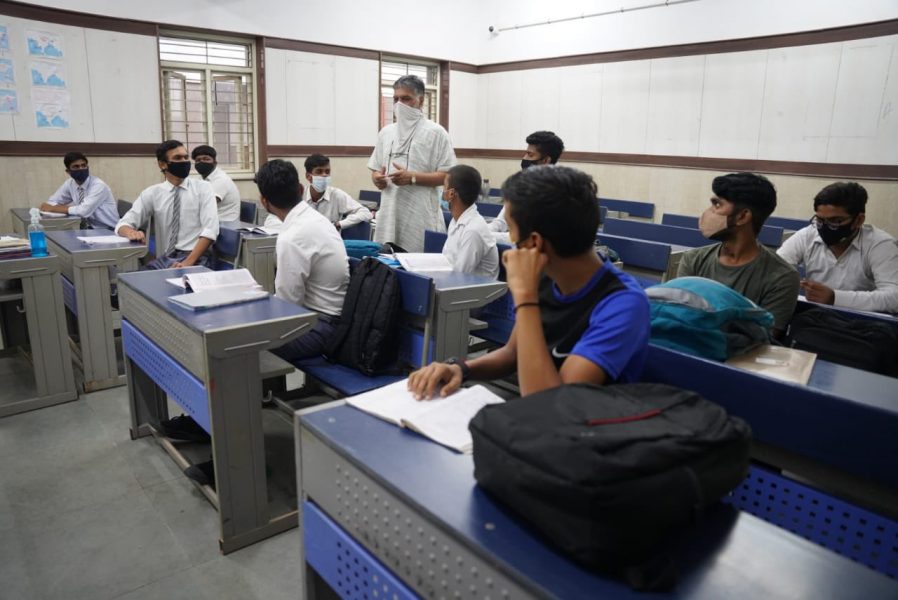
Schools fret over hybrid teaching as Bengal braces to restart offline classes

Schools are bracing for the challenges of hybrid teaching after the West Bengal government announced to resume physical classes for 9 to 12 along with colleges and universities from November 16.
Though the state government is yet to come out with a standard operating procedure (SOP) for conducting in-person classes, it is learnt that initially the teaching will be blended—a mix of online and offline classes.
Chief Minister Mamata Banerjee earlier this week instructed Chief Secretary HK Dwivedi to do necessary preparations for the resumption of classes, some 20 months after the pandemic forced them to close schools.
Half of the students of a class will come to schools on alternate days while the other half will attend classes online from home if a draft guideline prepared by the state education department gets the approval of the state secretariat.
The guidelines have been forwarded to the secretariat for the chief minister’s nod, said an education department official. The chief minister will soon announce the SOPs after examining the guidelines, he added.
The draft guidelines also suggested several other measures like avoiding morning assembly; not to allow more than two students to sit on a bench; staggered entry, exit and break timings for students of different classes, besides adhering to basic COVID protocols like wearing mask, maintaining social distance, regular sanitisation of classes etc.
Many government-run and government-aided schools, particularly those in rural areas, have conveyed to the education department about their infrastructural constraint in conducting hybrid classes.
“Most schools in rural areas are short of teachers. So, it will be very difficult to simultaneously conduct online and in-person school,” said Kingsuk Halder of Pachuakhali High School in South 24 Parganas district.
Education department officials, however, said that to maintain strict physical distance in the classes, it is imperative that each student attends physical classes on alternative days. He, however, quickly added that a final decision in this regard would be taken at the highest level.
“The experience was not very successful in February. Most schools could not run parallel offline and online classes because of lack of infrastructure and manpower,” said a teacher of Kalna Ambika Mahismardini High School in East Burdwan district.
Also read: Bengal govt rethinks schools reopening as COVID cases surge
She pointed out that in any case, schools will have to continue online teaching for classes below nine.
Schools in the state had reopened for Classes 9 to 12 in February this year. But the government had to shut them again in April following a renewed surge in COVID cases.
The West Bengal government’s latest decision on resuming in-person classes comes at a time when the number of COVID-19 cases is rising in the state after uninhibited Durga Puja celebrations. The surge forced the alarmed authorities to create 129 containment zones across the state, with the maximum of 43 in the North 24 Parganas district.
The state recorded 976 new COVID-19 cases with a positivity rate of 2.25 per cent and 15 fatalities on Wednesday. The state reported 806 new cases on Tuesday.
“The current trends of increasing daily new cases and case positivity if left unchecked may lead to a situation where there is a severe strain on the health infrastructure and health workforce,” the Centre warned the state in a recent communiqué.
Union health secretary Rajesh Bhusan conveyed the Centre’s concern to West Bengal health secretary Swaroop Nigam in a letter dated October 22.
“West Bengal has reported 20,936 new cases and 343 new deaths, accounting 3.4 per cent of India’s new cases and 4.7 per cent of new deaths in last 30 days,” Bhusan said observing that “cases surge exponentially in instances where basic public health strategy ( testing, tracking, treatment, COVID-appropriate behaviour and vaccination) is not followed rigorously.
He further directed the state government to ensure strict adherence to COVID-appropriate behaviour and focus on second dose coverage of COVID vaccines.
Only about 2.03 crore people got both doses of vaccines in the state out of over 7. 39 crore vaccinated as on Wednesday (October 27).
Only two in every 1,000 people, that is 0.20 per cent, contracted coronavirus after taking double doses of the COVID vaccine, according to a recent survey conducted by the state health department. The survey was done on 11,200 people in 28 hospitals in the state.
The survey found that effectiveness of the vaccine (Covaxin/ Covishield) at least after 28 days of second dose is 84 per cent while it is 74 per cent after the first dose.


